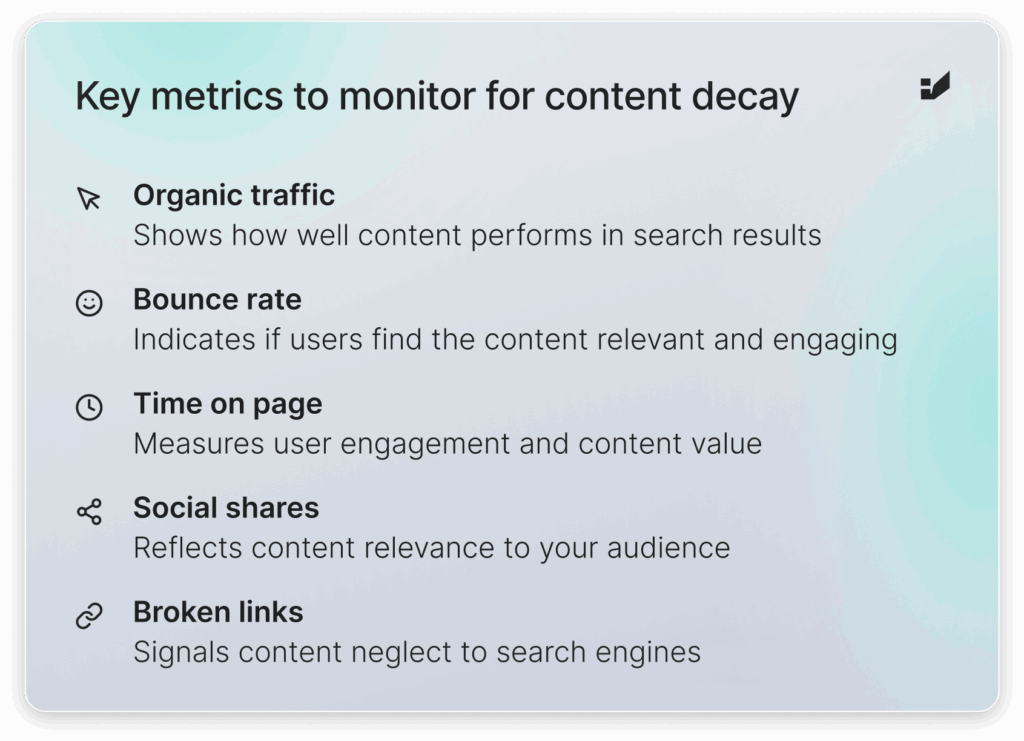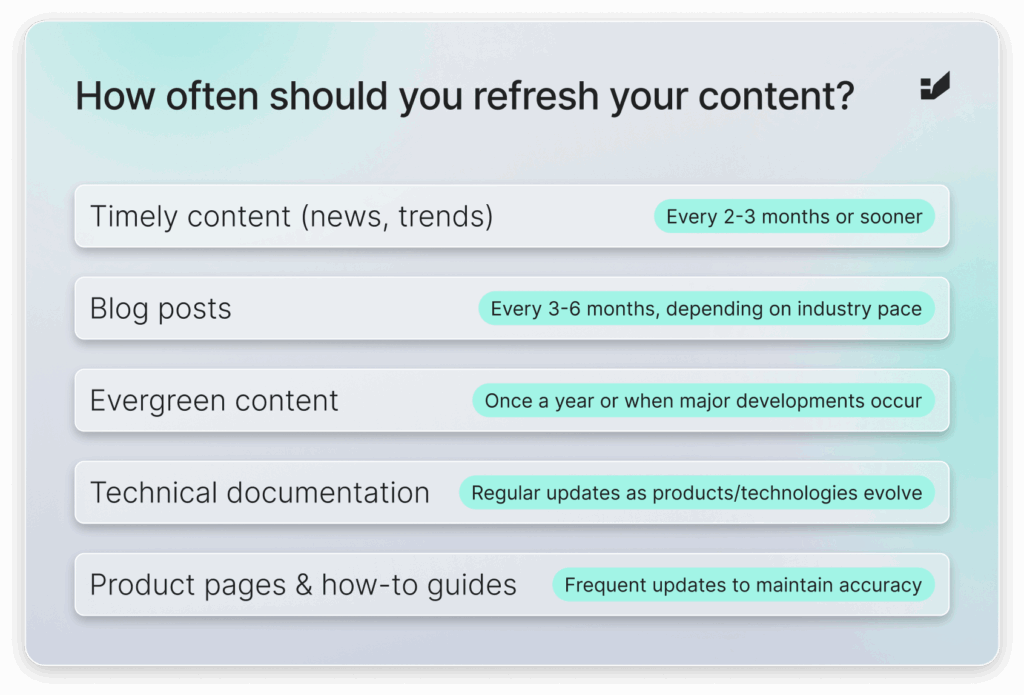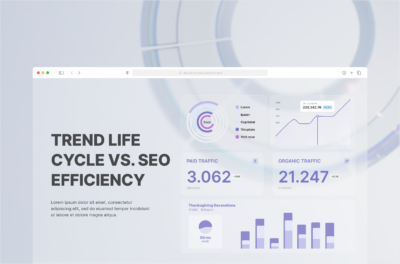Content decay in AI Search: How often should you refresh to stay relevant?
Content decay has become a real headache for marketers and content creators. As search engines like Google lean more heavily on AI and algorithms to show relevant results, you need to understand how content decay affects your visibility and rankings.

This article explores what content decay means, how it impacts SEO and AI Search, and how often you should refresh your content to keep organic traffic and user engagement healthy.
Understanding content decay
Why does content decay happen?
Content decay happens for several reasons, mostly because user search intent keeps changing and new content keeps appearing. When trends shift and fresh information comes out, older content can become outdated or irrelevant, which means it gradually loses visibility on search engines. Links break over time, and metrics like bounce rates tell search engines that a piece of content isn’t working anymore. All these factors add up, which is why marketers need to keep a close eye on how their content performs.
How does content decay impact SEO?
Content decay can seriously hurt your SEO because search engines want to deliver high-quality, relevant information to users. When content gets outdated, its ranking drops, which means you lose organic traffic and visibility. This hurts the overall user experience since visitors find outdated or irrelevant content unhelpful. Businesses often see their engagement metrics suffer- things like time spent on page or conversion rates – which makes SEO rankings drop even further.
The role of AI in Search Engine Optimization
How does AI change the landscape of search?
AI has completely transformed how search works by improving the way search engines understand user queries and deliver results. With sophisticated algorithms that analyze massive amounts of data, AI helps search engines grasp user intent much better. This means high-ranking content needs to be well-written and keyword-optimized, but also relevant and fresh.
Tools like SEMrush and Ahrefs give you valuable insights into how your content performs and where you can improve. By looking at user behavior and engagement metrics, businesses can spot trends and adjust their content marketing strategies. AI systems get better at recognizing decaying content, and marketers need to prioritize refreshing older pieces to maintain visibility and relevance in search results. AI in SEO means you need to take a proactive approach to content management, focusing on keeping things fresh and relevant.

What are the key features of AI Search algorithms?
AI search algorithms use several features that help them deliver relevant results to users. These include natural language processing and machine learning, which help algorithms understand context and semantics better. This understanding lets search engines evaluate content quality, relevance, and freshness, so marketers need to make sure their content meets these standards. The algorithms look at user engagement metrics, like click-through rates and time spent on pages, to see how well content meets user needs.
AI algorithms also prioritize fresh content, often favoring updated pieces over older, static content. This means businesses need to regularly refresh their content to avoid falling behind in search rankings. When you understand and adapt to the key features of AI search algorithms, you can optimize your strategies to boost visibility.
Why is AI Search more sensitive to content freshness?
AI search engines are particularly sensitive to content freshness because users increasingly demand timely and relevant information. Search engines want to improve user experience, so they prioritize delivering the most current content in response to specific queries. This means outdated content can quickly lose its ranking and visibility, leading to a drop in traffic. AI algorithms continuously learn and adapt, so they’re always looking for fresh content to give users the most relevant results.
Identifying decaying content
How can you spot content decay on your website?
Spotting content decay on your website is crucial for maintaining an effective content strategy. Start with a comprehensive content audit where you analyze each piece of content for performance metrics, engagement levels, and relevance to current trends. Content that’s seen a gradual decline in organic traffic or has high bounce rates probably shows signs of decay. Also, watch for outdated statistics or broken links – they help pinpoint content that needs refreshing. Tools like Google Search Console give you valuable insights into how content performs over time, making it easier to identify decaying content.
User feedback and engagement can also tell you a lot about content relevance. Comments, shares, and interactions show whether users find the content valuable or if it’s become obsolete. Regularly reviewing and optimizing content based on these metrics helps you keep your digital assets fresh and engaging. When you take a proactive approach to identifying content decay, you can implement strategies to revitalize older content and make sure it continues to meet user needs, which ultimately supports your SEO efforts.
What metrics should you monitor for content performance?
Monitoring the right metrics is essential for assessing content performance and spotting signs of content decay. Key metrics include organic traffic, bounce rates, and user engagement levels. Organic traffic shows how well content performs in search engine results, while high bounce rates might mean users aren’t finding the content relevant or engaging. Metrics like time spent on a page, social shares, and comments give you insights into user interaction and satisfaction with the content.
Google Analytics and SEMrush help you track these metrics, letting you identify trends and make informed decisions about content strategy. By regularly analyzing performance metrics, you can pinpoint pieces of content that need updates or optimizations to fight content decay. Understanding the relationship between these metrics and content relevance can improve your overall SEO performance, making sure your digital assets continue to meet user needs in a dynamic online environment.

How often should you review your content for relevance?
How often you review your content depends on several factors, including industry trends, content type, and overall performance. Generally, you should conduct content audits at least quarterly to make sure pieces stay aligned with current trends and user interests. However, if you’re in a highly dynamic industry, you might need more frequent reviews to keep up with rapid changes. By regularly assessing content, you can identify which pieces have started to experience content decay and need refreshing.
Strategies for refreshing content
What are the best practices for updating old content?
Start by revisiting the original piece and evaluating its relevance given current trends and information. This might include updating statistics, adding new insights, and revitalizing the piece with fresh perspectives or examples. Adding relevant keywords can also help optimize the content for search engines and boost its visibility.
Make sure that links within the content actually work and lead to reputable sources. Broken links hurt user experience and signal neglect to search engines. By fixing broken links and adding new, high-quality resources, you boost the credibility and value of the updated content. You should also promote refreshed content through various channels, like social media and email marketing, to maximize its visibility and reach. These best practices can significantly boost the effectiveness of older content and fight content decay.
How can you use analytics to guide content refreshing?
Analytics play a crucial role in guiding content refreshing strategies by giving you valuable insights into user behavior and content performance. Using tools like Google Analytics, you can track various metrics, including organic traffic, bounce rates, and user engagement levels.
Analyzing these metrics helps identify which pieces of content are underperforming and might need updates to combat content decay. For instance, a sudden drop in organic traffic or increased bounce rates could signal that the content no longer meets user needs or expectations.
Segmenting analytics data by user demographics or behavior can reveal patterns that inform content refresh decisions. Understanding your target audience’s preferences and interests lets you tailor updates to better align with their needs.
By leveraging analytics to guide content refreshing, you can make sure your digital assets remain relevant, engaging, and optimized for search engines. This proactive approach combats content decay and enhances your overall content strategy and SEO performance.
What types of content are most worth refreshing?
When it comes to refreshing content, certain pieces are more valuable to update than others. High-traffic blog posts, cornerstone content, or pieces that historically performed well in search engine rankings are excellent candidates for refreshment.
These types of content often have established authority and can significantly benefit from updates that keep them aligned with current trends and information. Content that addresses frequently asked questions or common pain points can also provide substantial value when refreshed, since users consistently seek reliable answers and solutions.

How often should you refresh your content?
What factors influence the frequency of content updates?
Several factors influence how often you update content, including industry trends, content type, and the competitive environment. In fast-paced industries, content might need more frequent updates to stay relevant, while slower-moving sectors allow for longer intervals between refreshes.
The type of content also plays a significant role; evergreen content, for instance, might need less frequent updating compared to timely news articles or trend-driven pieces that quickly become outdated.
How do industry trends affect content refresh timing?
Industry trends play a pivotal role in determining when to refresh content. In sectors that continuously change, like technology or fashion, content can quickly become outdated, which means you need more frequent updates to maintain relevance.
Keeping up with emerging trends, news, and user interests is essential for marketers to make sure their content aligns with current demands. If you don’t refresh content in response to industry trends, you risk losing visibility and engagement, which ultimately impacts SEO performance.
Google Trends and social media analytics help you identify shifts in user interests and preferences. Understanding how industry trends affect content refresh timing helps you stay agile and responsive, making sure your content remains valuable and engaging to users.

What is the ideal refresh frequency for different content types?
The ideal refresh frequency varies significantly based on content nature and purpose. For example, blog posts covering timely topics or current events might need updates every few months or even sooner, depending on how fast your industry changes. Evergreen content that provides foundational knowledge or insights might only need occasional reviews, typically once a year or whenever significant developments occur within the field. Understanding the differences in content types helps you establish appropriate refresh schedules.
Technical documentation, product pages, or how-to guides often require more frequent updates, especially as products or technologies change. Regularly reviewing these types of content makes sure they remain accurate and relevant to users’ needs.
Having this in mind, you can develop a refresh strategy that enhances visibility, user engagement, and overall SEO performance. Establishing an ideal refresh frequency tailored to each content type is essential for fighting content decay effectively.



